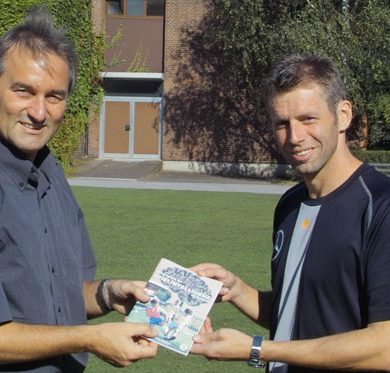 Beat the 4-2-3-1 formation
Beat the 4-2-3-1 formation
Discover how the hidden weaknesses of this formation can be exploited and how teams playing it can be beaten, time after time.
Finally, a game plan for beating the 4-2-3-1! This book provides the blueprint for exploiting the defensive frailties and playing tendencies that make the 4-2-3-1 more vulnerable than most coaches realize. Bring your coaching knowledge up-to-date on how today’s dominant elite level formation can be defeated and gain the insights you need to set your team up to win.
Order this E-Book here
We’ve all watched how the 4-2-3-1 has evolved to become the formation of choice for many of the world’s elite teams. We’ve all nodded in agreement when we’re told that the 4-4-2 will soon be confined to the dustbin of history and that fluid, rotational formations are the future. Well, we have news for you, because we have the blueprint for how the 4-2-3-1 can be beaten.
Beating the 4-2-3-1: Analyzing the Strengths and Weaknesses of the 4-2-3-1 and How to Coach Your Team to Defeat It is a special book that reveals the weaknesses, frailties and blind spots of this popular elite level formation. It reveals how teams like Bayern Munich, Manchester United and Real Madrid might soon find their midfield wings clipped and defensive midfielders bamboozled into being out of position by teams that know the secret to how the 4-2-3-1 can be beaten.
Discover the inner workings of the 4-2-3-1 and why it has, up until now, been so effective against more rigid sides. Then find out how you can overcome and exploit the weaknesses of this common and modern style of play, with an extensive set of drills for training your players in the tactics needed to beat it.
“I read Stevie’s new book with great interest as it gave me really detailed information on the strengths and weaknesses of the 4-2-3-1. This is great information which I can use with my teams and coaching groups. I also liked the roles for the individual players and how he related this to current players, and this is something that my young players will be able to visualize and incorporate into their play. The final part of the book that has the practice content will be really useful for me. They are all easily understood with accompanying diagrams and I can recommend them to coaches at all levels as they will be a real benefit to teams and individuals.” – Neil Mackintosh, Scottish FA Performance Development Manager
Order this E-Book here
“Unearth the reasons why a formation that has evolved over the last decade might soon be history”
The 4-2-3-1 was first launched onto soccer pitches in the late 90s by Arsenal under Arsene Wenger. With Denis Bergkamp playing just behind the strikers accompanied by adventurous wingers, Arsenal enjoyed years of success running rampant in front of goal, and even went a whole season unbeaten. The formation was then adopted by France on their march to victory in the Euro 2000 tournament before spreading to clubs throughout Europe, with it used by elite teams includingBorussia Dortmund, Paris St Germaine, Manchester City and Barcelona.
Until now the advantages of a triangle midfield, attacking fullbacks and an extra wall of defensive midfielders has left opposing teams baffled. Well, now the secret is out, because Beating the 4-2-3-1 explains exactly how the formation can be exploited, overrun and beaten time and again.
“Gain insights from a coach with a track record of developing players in three countries”
Stevie Grieve started coaching at the young age of 16 with Perth Youth Futsal in his native country of Scotland. During his tenure he was instrumental in producing players for the Elite U14, U15 and U16 teams, which all went on to win domestic and international tournaments.
Eager to further develop his coaching experience, Grieve took the bold step of establishing his own youth team, the Letham Tangerines. Again, his coaching methods successfully produced players for various Elite Youth Academy Team every season. Grieve’s reputation as an excellent technical coach grew while with the Tangerines, accumulating an impressive 14-1-1 record, ending the season as league winners and double cup winners, finishing runners up in the 3rd cup final on penalties.
Order this E-Book here
Grieve would then spend six months coaching in New Jersey, USA, at three different travel soccer clubs before moving back to Scotland to coach at Dundee. He spent two seasons at Dundee as the U17 coach before moving to Raith Rovers then East Fife, where he was employed both times as a talent scout and youth coach.
Grieve then made the move abroad to Intersoccer in Switzerland, where he continues to work today as a youth coach and coach development consultant. In his current role Grieve helps to develop the structure for educating coaches in how to put the right skills in the right order to accelerate skills acquisition. He is now the head coach of, the Swiss team FC Gland 3.
A core part of Grieve’s coaching philosophy is that coaches must help players to understand why they make certain decisions while in possession and to show coaches innovative ways of maintaining and stimulating players’ interest beyond traditional drills and exercise. This approach has helped to develop over 20 players that have been selected by professional youth soccer academies.
Grieve has written various books, including the Best-Seller, Coaching the 4-2-3-1, Coaching the 4-2-3-1 Advanced Tactics, Modern Soccer Tactics 1 & 2, Winning Soccer Tactics, and has passed various coaching courses, including a FIFA Advanced Futsal Diploma, Scottish FA ‘B’ Licence for Youths Coaching and has recently passed his Scottish FA ‘A’ License for Children’s Coaching.
Order this E-Book here
What’s covered in Beating the 4-2-3-1
Beating the 4-2-3-1: Analyzing the Strengths and Weaknesses of the 4-2-3-1 and How to Coach Your Team to Defeat It exposes the formation’s strengths and weaknesses and how to coach your team to defeat it. It shows you the formation’s inner workings, which formations can overcome it and how to exploit the weaknesses of this common and modern style of play.
Beating the 4-2-3-1 first looks at the formation’s evolution from a 4-4-2, with the addition of an advanced playmaker, a triangular midfield and attacking fullbacks, and the reasons why, up until now, it has been so successful.
Grieve then looks at the formation’s setup, analyzing the roles and responsibilities of each player in depth. He then uses Real Madrid and Manchester United as examples to assess the defensive strengths of each line of the team when in possession and its defensive weaknesses, such as the spaces that can be created in the corners when advanced fullbacks don’t pullback to defend quickly enough.
The book then explains how to exploit the defensive weaknesses of the 4-2-3-1. This includes exploiting the space between the fullback and the wingers with different formations and how to attack centrally by creating 3 v 2 situations in front of the opposition’s defense. Diagrams are provided along with an explanation of how each position can be vulnerable to certain styles of play.
Grieve then uses Barcelona against Real Madrid as a case study example with screenshots of the game, where Pedro, Alves, Messi and Villa all combined to exploit gaps mercilessly and emerge victorious in one of the many epic encounters between Spain’s dominant sides.
Order this E-Book here
Other examples Grieve uses to highlight the blind spots of the 4-2-3-1 include Napoli’s drawing ofChelsea’s defensive midfielders, the overloading of midfield between Brazil and Holland and how Italy dribbled to eliminate Spain’s holding midfielder.
The final third of Beating the 4-2-3-1: Analyzing the Strengths and Weaknesses of the 4-2-3-1 and How to Coach Your Team to Defeat It then focuses on the practical side, with an extensive array of training sessions for drilling your players in how to defend against the formation and how to attack against it. Totaling 13 sessions in all, each session has three different activities along with progressions within the same setup.
What you will gain from Beating the 4-2-3-1
Beating the 4-2-3-1 reveals the strengths and weaknesses of this highly attacking formation and how to coach your players to defeat it. Featuring an analysis of the formations that can beat it along with an extensive selection of handpicked drills and exercises, from Beating the 4-2-3-1 you will gain:
- In-depth analysis of the 4-2-3-1, its history, playing tendencies and the roles and responsibilities of each player
- How to exploit its defensive weaknesses by pressing defensive midfielders and finding space on the flanks
- Which formations can exploit the weaknesses of the 4-2-3-1 and how
- Numerous examples of real life games where the frailties of the 4-2-3-1 have been exposed
- How to exploit spaces in the 4-2-3-1 when it’s in transition
- Using and exploiting overloads in gaps created by the 4-2-3-1
- Drills for transitions and overloading in attack
- Where to look for quick passes against their fullbacks
- How to build attacks against the 4-2-3-1 from the back
- Unlocking the winger in space between wide players
- High pressure defending on the sides against the 4-2-3-1
- Stopping central penetration by a triangle midfield
Order this E-Book here
While the formation of choice for elite sides, the 4-2-3-1 is finding itself being used by teams at every level, wishing to capitalize on its fast paced passing and reliance on possession. So whether you coach elite players, university teams or recreational sides, every coach can benefit from the insights and analysis in Beating the 4-2-3-1.
“I am constantly coming across teams that are playing the 4-2-3-1, and after reading, “Beating the 4-2-3-1″, I will now be better prepared. It gives me an inside look when the system starts to take shape and evolved during the years. For me it’s like reading the missing chapter of the book “inverting the pyramid” by Jonathan Wilson.
4-2-3-1- formation
I will use the attacking and defending training sessions in the book with my own team and teach them how to exploit the weaknesses of the 4-2-3-1. I can’t wait to get started.” – William van Weert, Coach RKSV Heeze, K.N.V.B. licensed Junior soccer coach
“Discover the weak spots and frailties of the 4-2-3-1, and train your players in the tactics to defeat it”
Over the last few years the 4-2-3-1 has risen to prominence as the formation of choice for highly technical sides able to play fast paced passing soccer. Its adoption by three of the four semi finalists in the Euro 2012 tournament reflects how it looks set to dominate soccer in the years ahead. That might change now that its weaknesses have been identified and coaches are developing strategies to beat it.
Beating the 4-2-3-1 is the most comprehensive guide yet to overcoming the 4-2-3-1. It provides an in-depth analysis of all the formation’s weak spots and which formations can exploit them. What’s more, it also includes extensive drills that will coach your players with the tactics and mindset they need to be successful. So fear the 4-2-3-1 no longer. Add Beating the 4-2-3-1 to your coaching library and gain the blueprint to exploiting its weaknesses and setting your team up to win.



